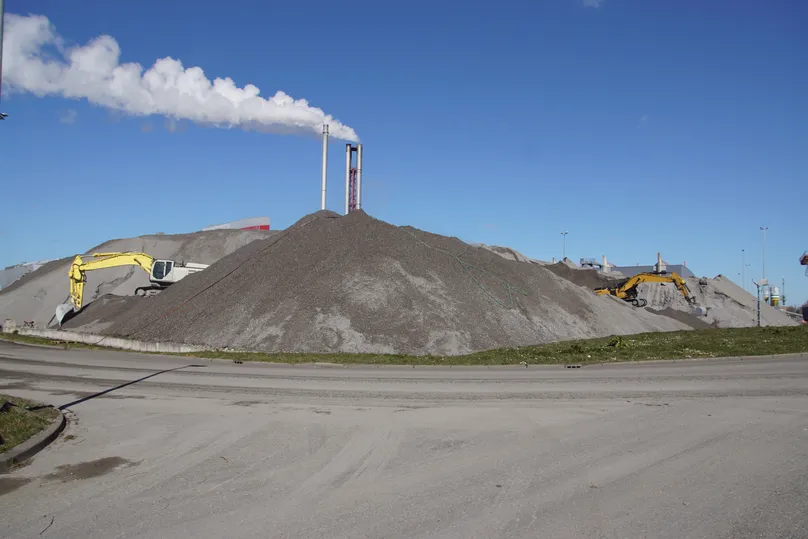Bottom ash
Bottom ash (BA) is a by-product of coal combustion in power plants. When pulverised coal is combusted in the furnace, ash of varying particle sizes is generated. The sand-sized ash collected from the bottom of the furnaces is called BA and it accounts for approximately 10% of the total generated ash.
Other sources of BA generation include energy-from-waste incineration facilities where BA makes up 70 – 90% of the total generated ash. However, this process currently operates on a much smaller scale in Australia.
How is it processed?
Bottom ash (BA) is a by-product of coal combustion in power plants. When pulverised coal is combusted in the furnace, ash of varying particle sizes is generated. The sand-sized ash collected from the bottom of the furnaces is called BA and it accounts for approximately 10% of the total generated ash.
Other sources of BA generation include energy-from-waste incineration facilities where BA makes up 70 – 90% of the total generated ash. However, this process currently operates on a much smaller scale in Australia.
Environmental, health, and safety
BA contains different levels of heavy metals and other toxic elements that can harm both the environment and human health if not properly managed. Fine BA particles can also become airborne during handling, posing respiratory risks. Leachate and toxicological assessments should be conducted to ensure that contamination levels in a BA stockpile comply with Environmental Protection Authority specified thresholds. Additionally, personal protective equipment must be worn when handling BA.
Applications
BA can be used as both unbound and bound material in various infrastructure applications. These include:
- as an aggregate in unbound granular subbase (content limits up to 10%)
- as stabilised subbase and base layers of roads
- as an aggregate for concrete, bitumen bound road base and wearing courses
- as abutment fill to replace virgin quarried materials
Specifications
There are no specifications in place for the use of BA in infrastructure in Western Australia, and its use may be on a trial/ research basis.
The only road agency that has specifications for the use of BA is Transport for New South Wales (TfNSW), which allows 10% by mass of BA to be used in base and subbase layers as granular material. Additionally, TfNSW allows the use of BA in public road related activities, such as road construction and maintenance, but does not specify any limits or requirements for these applications.
The Public Transport Authority and Main Roads Western Australia have pavement, concrete and earthworks specifications that would need to be considered for implementation of bottom ash.
Benefit and challenges
BA is a reliable granular material for replacing natural aggregates, such as gravel and sandy soils. Using BA as a total or partial replacement provides environmental benefits by reducing the consumption and processing of natural aggregates and preserving valuable landfill space, as well as economic benefits.
However, BA has seen limited use in Australia due to a lack of understanding of the material and the absence of specifications to guide its application in transport infrastructure.
Previous use in Western Australia
BA is an emerging road construction material in Australia with an undeveloped market. In 2018, approximately 1.34 million tonnes of BA was generated in Australia, with only 47.6% being recycled. In 2022, Blue Phoenix Group built Australia’s first incinerator bottom ash (IBA) processing facility in Hope Valley, Kwinana, Western Australia.
The plant has the capacity to process about 140,000 tonnes of IBA annually, recovering metals, and repurposing the residual BA aggregates for both bound and unbound civil applications. However, to date, BA has not been used in any major projects in Western Australia.

References
- Transport for New South Wales (TfNSW) 2020, Granular pavement base and subbase materials, Specification D&C 3051, TfNSW, Sydney, NSW.
- Transport for New South Wales (TfNSW) 2020, Earthworks, Specification D&C R44, TfNSW, Sydney, NSW.
- Hall, B, Grenfell, J, Pandelidi, C, Yaghoubi, J, Chaudry, U, Lyons, M, O'Connor, G, Harrison, J & Feigen, D 2022, Best practice expert advice on the use of recycled materials in road and rail infrastructure: part A technical review and assessment.
- Hall, B, Grenfell, J, Pandelidi, C, Yaghoubi, J, Lyons, M, O'Connor, G, Harrison, J, Feigen, D & Xue, S 2022, Best practice expert advice on the use of recycled materials in road and rail infrastructure: part B sustainability impacts report.
- Thomas, M, Jewell, R & Jones, R 2017, Coal fly ash as a pozzolan, In Coal Combustion Products (CCP's) (pp. 121-154). Woodhead Publishing.
- Blue Phoenix 2024, Blue Phoenix ready to launch Australia-first IBA facility, Building a sustainable future, viewed 1 October 2024, <https://www.bluephoenix-group.com/regions/australia/news-case-studies/blue-phoenix-ready-to-launch-australia-first-iba-facility/ >.